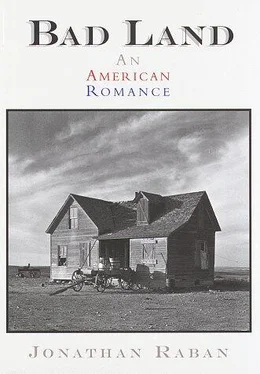In 1902 the top spot on the list was held by Owen Wister’s The Virginian (which would go on to sell 1,623,000 copies in hardback), a requiem for the Noble Cowboy and the open range of Wyoming. Wister called his novel “an expression of American faith” and dedicated it to his friend Theodore Roosevelt (“the greatest benefactor we people have known since Lincoln”). Wister’s preface to the reader goes straight to the emotional center of the book:
Had you left New York or San Francisco at ten o’clock this morning, by noon the day after tomorrow you could step out at Cheyenne. There you would stand at the heart of the world that is the subject of my picture, yet you would look around you in vain for the reality. It is a vanished world. No journeys, save those which memory can take, will bring you to it now. The mountains are there, far and shining, and the sunlight, and the infinite earth, and the air that seems forever the true fountain of youth — but where is the buffalo, and the wild antelope, and where the horseman with his pasturing thousands? So like its old self does the sage-brush seem when revisited, that you wait for the horseman to appear.
But he will never come again. He rides in his historic yesterday. You will no more see him gallop out of the unchanging silence than you will see Columbus on the unchanging sea come sailing from Palos on his caravels.
… What is become of the horseman, the cow-puncher, the last romantic figure on our soil? … Well, he will be here among us always, invisible, waiting his chance to live and play as he would like. His wild kind has been among us always, since the beginning …
How could twentieth-century America still be worthy of — and still find room for — the quintessential American, the free spirit, the horseman? A sort-of answer was provided by Jack London’s The Call of the Wild , published in 1903 (1,752,000 copies sold). London’s story of a dog who, on the death of his master in San Francisco, made his way back to the wilds and became the leader of a wolf pack, was a sermon about the ungainsayable power of atavism. The true American will not be long content with a life of rubber bones in the doghouse. The unfettered prairie and our wolf ancestors beckon.
Another answer was suggested by the 1908 bestseller The Trail of the Lonesome Pine , by John Fox, Jr. (1,285,000 copies), a riot of purple nature writing set in the Cumberland Mountains’ on the Virginia — Kentucky border. The search for coal to fuel the railroads and factories brings “the smoke and steam and bustle and greed of the twentieth century” to the idyllic green world around the lonesome pine, and the plot centers on a love affair between a mountain man’s daughter and a mining engineer. The beautiful girl gets to him, and so does the beautiful landscape; by the end of the book, the engineer has become an ardent conservationist.
All the time they talked of what they would do with Lonesome Cove.
“Even if we do go away, we’ll come back once a year,” said Hale.
“Yes,” nodded June, “once a year.”
“I’ll tear down those mining shacks, float them down the river and sell them as lumber.”
“Yes.”
“And I’ll stock the river with bass again.”
“Yes.”
“And I’ll plant young poplars to cover the signs of every bit of uptorn earth along the mountain there. I’ll bury every bottle and tin can in the Cove. I’ll take away every sign of civilization, every sign of the outside world.”
“And leave old Mother Nature to cover up the scars,” said June.
“So that Lonesome Cove will be just as it was.”
“Just as it was in the beginning,” echoed June.
“And shall be to the end,” said Hale.
Hale and June are about to conceive an Appalachian version of Roosevelt’s darling, the Yellowstone National Park.
Rebecca of Sunnybrook Farm by Kate Douglas Wiggin (1903, and it sold 1,357,714 copies) found the ideal simple life in rural Maine. Rebecca, after many modest adventures and vicissitudes, unexpectedly inherits the beloved farm of the title. Her farm will reunite her scattered and dysfunctional family, and on the last page of the book Rebecca is found thanking God for this gift of healing real estate:
She sat in the quiet doorway, shaded from the little Riverboro world by the overhanging elms. A wide sense of thankfulness and peace possessed her, as she looked at the autumn landscape, listened to the rumble of a wagon on the bridge, and heard the call of the river as it dashed to the sea. She put up her hand softly and touched first the shining brass knocker and then the red bricks, glowing in the October sun.
It was home; her roof, her garden, her green acres, her dear trees; it was shelter for the little family at Sunnybrook; her mother would have once more the companionship of her sister and the friends of her girlhood; the children would have teachers and playmates …
… garden … acres … trees . Many of the book’s readers had none of these, and the words had a talismanic vibrance. To inherit a farm was as happy a fate as could be imagined. It was to inherit the earth.
Gene Stratton-Porter’s A Girl of the Limberlost came out in 1909 and sold 2,053,892 copies. The novel is set in small-town Indiana and Michigan — an area that must have seemed pretty wild and remote to most readers. But in Stratton-Porter’s book, suburbanity is encroaching fast. There are trolley lines in Onabasha, the hometown of Elnora Comstock, who lives with her embittered mother on the edge of town, by the remains of the Limberlost swamp. For the wetlands are being drained, the forest has largely gone, and even distant Mackinac Island, in the straits between Lakes Michigan and Huron, has become a vacation resort.
The Limberlost is the last surviving patch of primeval wilderness in a world already in the hands of the property developers. The owl, the grosbeak, the whippoorwill, the Luna moth still live there, but even in 1909 their survival is threatened. For Elnora, the swamp is the beautiful, moist, dangerous (her father was swallowed alive in the Limberlost) and vital source of authentic American values. She pays for her school textbooks and, later, her college education by collecting rare moths in the swamp and selling them to a naturalist in town known as the Bird Woman.
Near the end of the book, now grown up and on the edge of marriage, Elnora stays on Mackinac Island with her childhood friend Freckles (a boy of the Limberlost), his wife, the Angel, and their brood of young children. Freckles asks Elnora what she thinks of Mackinac:
“Oh, it is a perfect picture, all of it! I should like to hang it on the wall, so I could see it whenever I wanted to; but it isn’t real, of course; it’s nothing but a picture.”
“These people won’t agree with you,” smiled Freckles.
“That isn’t necessary,” retorted Elnora. “They know this, and they love it; but you and I are acquainted with something different. The Limberlost is life. Here it is a carefully kept park. You motor, sail, and golf, all so secure and fine. But what I like is the excitement of choosing a path carefully, in the fear that the quagmire may reach out and suck me down; to go into the swamp naked-handed and wrest from it treasures that bring me books and clothing, and I like enough of a fight for things that I always remember how I got them. I even enjoy seeing a canny old vulture eyeing me as if it were saying: ‘Ware the sting of the rattler, lest I pick your bones as I did old Limber’s.’ I like sufficient danger to put an edge on life. This is so tame. I should have loved it when all the homes were cabins, and watchers for the stealthy Indian canoes patrolled the shores …”
Stung by Elnora’s dismissal of his lovely island, Freckles sheepishly justifies it as a merely temporary move: “This is secure while the children are so small, but when they grow larger, we are going farther north, into real forest, where they can learn self-reliance and develop backbone.”
Читать дальше












